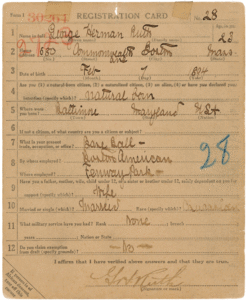
And tearing the corner off integration
Despite the hoarding habits of certain federal officials, The National Archives still has a big inventory. Military history stuff. And baseball stuff. It marked the start of spring training, for example, by publishing Babe Ruth’s World War I draft registration form. It helped keep the Army segregated.
Those of us prone to plunging down rabbit holes fall hard for historic documents like this. The Babe was twenty-three years old when he signed it. (Or twenty-two; he got his birth year wrong on the form.) Nevertheless, the document’s date is 1917, the year the U.S. declared war on Germany.
The torn corner
Of special interest, the form asks persons “of African descent” to tear off the lower left hand corner of the form before submitting it. With a small tear, you could inform the then-segregated military it could exclude and demean you at will. If particularly unlucky, you could get killed in the bargain. Some 700,000 Black men nevertheless tore the corner off before the war ended.
Mark Tomasik showed up somewhat deeper down the Babe Ruth rabbit hole. Tomasik is a retired journalist and a member of United Cardinal Bloggers, which is part of the Baseball Bloggers Alliance and a welcome addition to my large portfolio of ways to put off work. Tomasik’s blog is called “RetroSimba” and marches its way through St. Louis Cardinals history. His January 7, 2019, post was headlined Wife’s death opened secrets to the personal life of Babe Ruth. I could not resist.
Despite his draft registration Ruth – then an ace pitcher as well as hitter for the Boston Red Sox – didn’t serve in World War I. In 1924, though, he enlisted in the New York National Guard. He wasn’t called up then either, not least because he hit .378 and 46 home runs over 153 games that year. And he had just fallen in love with Claire Hodgson, a model and actor in Broadway chorus lines.
Forkball love life
The “wife” he refers to in the 1917 document, however, was Helen Woodford Ruth, 19 at the time. Four years later, in 1921, the happy couple showed up at the Polo Grounds with their 15-month old daughter Dorothy. The existence of a daughter shocked everyone who knew Babe Ruth. It was presumably a shock to Helen as well, for the child was the result of a 1920 affair Ruth had with one Juanita Jennings. And though Jennings (“Aunt Nitti”) stayed in Dorothy’s life, Helen had adopted the child in 1921.
Helen Ruth and Babe Ruth separated in 1925. Helen stayed in the couple’s 16-room house in Sudbury, Massachusetts. The Babe settled in New York and, not surprisingly, frequently at Claire’s Manhattan apartment. Helen asked for a divorce and $100,000 in 1928. Ruth angrily rejected the demand and their relationship remained a marriage in name only.
On January 11, 1929, however, a Dr. Edward Kinder was paged from his seat at a boxing match at Boston Garden. There’d been a fire at his house. There was a fatality. The cause ultimately was amateurish home electrical repair and a short-circuit. The fatality was his wife, Helen Kinder. A subsequent newspaper account of the fire included her picture.
A local woman who saw the photo, and called police. That was not Helen Kinder. It was Helen Ruth, Babe Ruth’s estranged wife.
Newspaper reports portrayed Ruth as heartbroken. He sobbed at her funeral. Kinder apparently didn’t show up. The police did follow up on family suspicions that Ruth or Kinder murdered her but found no evidence that they were involved in the fire.